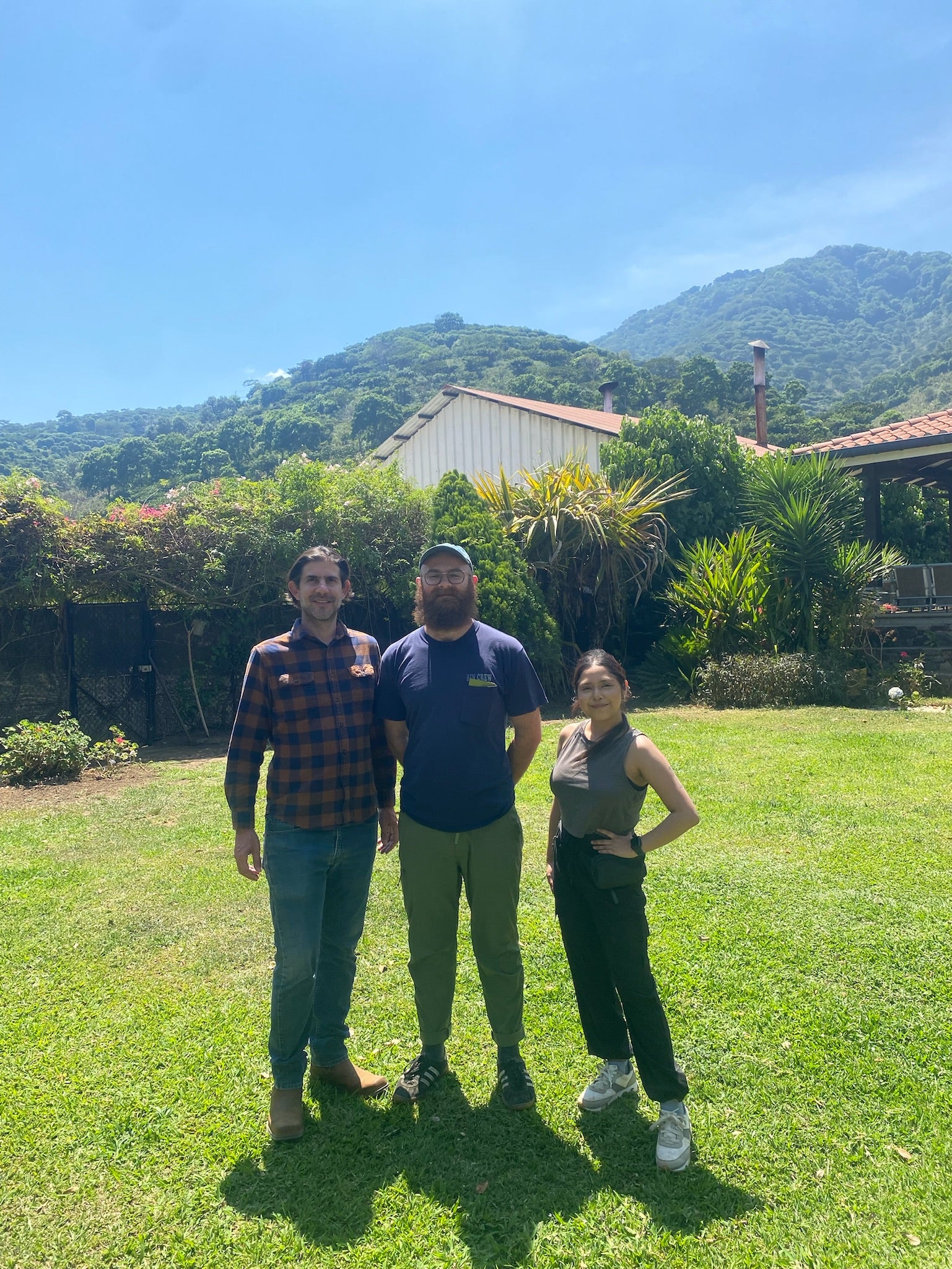My grandfather grew cotton. This was in the Texas High Plains, a stone’s throw from Lubbock, west towards New Mexico. When I was small, I would ride in his tractor, step clumsily between the cotton bolls, and drink water from the hose which glistened in the direct sun. That part of the world offers you no relief from flatness, and it’s a sea of red clay soil only halted by the horizon. The coffee farms I saw in El Salvador, while nearly exactly opposite, allowed space to wonder. Again, I was not working in those fields, but I could observe.
After a brief layover in San Salvador immediately after arriving in the country, the first images I had of Finca El Manzano were deep nothingness. The sun had set, and the man-made light offered was not enough for clarity. I could only feel the truck climbing ever higher, after escaping the paved road. We had dinner of pupusas filled with the requisite cheese, beans, and chicharron (rinsed thoroughly by Regia Extra) before enjoying a fire on the lawn of the main house, and heading to bed to discover later, as the sun reappeared, what this place actually looked like.

Daylight revealed rolling hills, a vast expanse leading to Santa Ana, which could be seen clearly miles away. Trees I didn’t recognize, birds that were definitely of paradise, nearly sheer fields that were recently stripped of their cash-crop. This was a different type of place, and it was beautiful for that. One of the resounding themes in conversation was that it’s normally much greener than this, or that the patient waiting for a real rain was becoming more urgent, which sounded funny, as the amount of green I saw was bordering on unreasonable.

As we toured the farms of Odyssey Coffees, it was clear that it was an operation. The wet and dry mills, the guardiolas, and the patios breathed a sigh of relief, having finished harvest 4 days before our visit. It was large, and climbing up the industrial machinery to get a birds-eye allowed me to soak in the amount of time, effort, and money it takes to build a coffee mill.
The coffees we tasted from Odyssey had a clear vision. Although they lean heavy into natural processing, the blend-centric (Pacas and Bourbon) profiles had clarity and careful balance between acid, sweetness, and bitterness. The micro lots were delicious as well, with the focus shifted to the pronounced texture, aroma, and wild flavors of Gesha, Pacamara, and SL-34 varieties.

After being handed off to our next hosts, we drove northwest to the mountains near Metapán. After 2 hours or so the pine trees made their presence known, with the oaks, and occasionally eucalyptus (with technicolor bark!) peeking through.
Near the border of Guatemala/Honduras and El Salvador, the CaféNor Mill was a sight to behold. At the epicenter of 95 partner farms, it had an impression that it truly grew from the soil around it. The cupping lab and the office there were both built from mud bricks and pine lumber from the land the mill is on. The raised beds sat before the precipice of a slope, hugged by the nursery where new plants were just beginning to soldier. There’s only one dry mill, and it’s astounding to me the amount of coffee that must be processed there.

As we cupped coffees from the producers of CaféNor, the terroir of the region was evident. High acid, lighter body, and a wonderful complexity of flavors represented. The Pacamaras I tried here were perhaps the most satisfying coffees I had in my time in the country, and having washed, semi-washed, honey, and naturals to try was a tapestry of what that variety can offer.
Eating at the house overlooking Anarqiua Farm in the evenings was beautiful. The omnipresent wind flapped the tablecloth, and the haze of the mountains turned the sunsets into pastel. We shared Pilsener, played foosball, and on one occasion ate arroz con calamares en su tinta (calamari and rice with ink), which was a black delight.

My thoughts during this trip veered from coffee quite regularly. Instead, I pondered our similarities, our differences, our shared struggles, and humanity. We all love something about what the Earth has to offer, and are compelled to pass a cup of its labors to our neighbor. We like to sit on the deck and learn about each other. We like to pick coffee cherries from the tree, and remove the flesh in our mouths before spitting the seeds. We like to cut a watermelon in half, and salt it before enjoying with family. We all look into the distance. We all stumble a bit before getting our footing on difficult terrain. We all get thirsty, and it’s likely that there will be someone next to you who can help.
Special thanks to Emilio, Adri, Javier, Alejandro, Maria, Alexander, Hugo, the trees and everyone else who allowed Angie and I to become immersed.
- CDH


